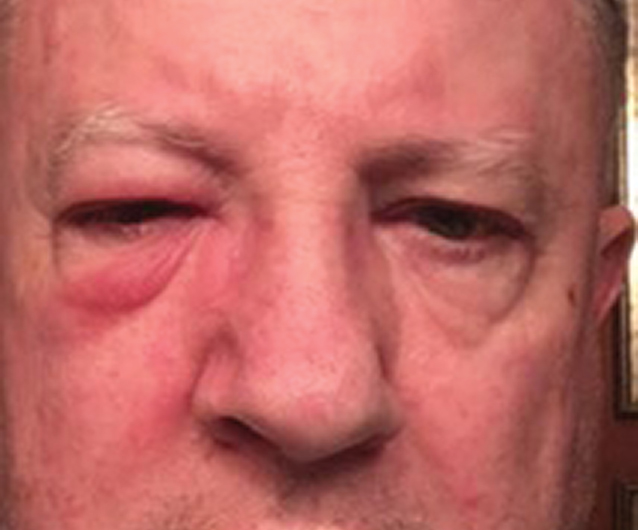 |
Q:
A patient presented with a two-week history of preseptal cellulitis, with no improvement after an ENT consult and four days of hospitalization with IV antibiotics. Other than facial swelling that was hard to the touch, he reported no pain or other symptoms. Any suggestions?
A:
“Preseptal cellulitis is an infection of the eyelid that occurs anterior to the orbital septum,” says Paige Thompson, OD, of SouthEast Eye Specialists in Chattanooga, TN. “Orbital cellulitis is a less common but more serious eyelid infection that involves the tissues posterior to the orbital septum.” The orbital septum provides an important boundary between the anterior eyelid and the deep orbital tissues.1,2
 |
| Preseptal cellulitis unresponsive to antibiotics could need dental extraction. Click image to enlarge. |
Presentation and Management
Preseptal cellulitis classically presents with unilateral eyelid edema and erythema, which can affect the skin above and below the lid. The most frequent underlying etiologies include an incipient chalazion, sinusitis and trauma.3,4
Preseptal cellulitis is managed with prompt treatment with oral antibiotics. Amoxicillin-clavulanic acid is often preferred, but Keflex (cephalexin, Advancis Pharmaceutical) and doxycycline (tetracyline class) are also used.5 Monitor patients daily until you note clear improvement.
“Patients should exhibit complete resolution of the condition within one week of antibiotic therapy,” Dr. Thompson says. “If preseptal cellulitis is not managed appropriately, infection can spread to the orbital septum via the venous system.”
Orbital cellulitis also presents with eyelid edema and erythema. These patients can exhibit proptosis, extraocular motility restriction, afferent pupillary defect and/or vision loss. This condition is most commonly caused by ethmoidal sinusitis, due to the proximity of the sinus cavities to the orbital structures.1,3,4
Refer all cases of suspected orbital cellulitis to an orbital specialist or the emergency department for prompt neuroimaging, especially those not responding to conventional therapy. “I prefer a CT scan of the brain, including orbits and sinuses,” Dr. Thompson says. After lab work, treat these patients with combined IV antibiotics followed by oral antibiotic therapy.
Tooth Infections
A lesser-known cause of preseptal and orbital cellulitis is dental infection. These infections are specifically associated with maxillary molar abscesses.6 The patient may not be complaining of localized tooth pain, which can cloud the diagnosis.
To diagnose suspected cases, endodontists can order a cone beam CT scan—a specific type of panoramic x-ray that provides detailed images of the jaw, teeth, nasal cavity and sinuses.7 “Always consider dental abscess in cases of preseptal cellulitis that are not responding to therapy,” Dr. Thompson says. Most of these cases require dental extraction to eliminate the infection.6,8,9
Our referral to the patient’s dentist and an oral surgeon resulted in the extraction of the infected molar and complete resolution of the facial cellulitis within a few days.
Preseptal and orbital infections may have serious consequences if not treated appropriately. Perform a thorough clinical examination, including visual acuity, pupillary assessment, extraocular motility evaluation and exophthalmometry in each of these cases.
“If the patient does not have a clear history of the common underlying causes we outlined, consider an underlying asymptomatic dental abscess,” Dr. Thompson says.
| 1. Babu PR, Prasad BD, Sowmya L, Sasanka KSBS. A review of preseptal And orbital cellulitis. J Evolution Med Dent Sci. 2016;5(20):1033-5. 2. Watts P. Preseptal and orbital cellulitis in children: a review. Paediatr Child Health. 2012;22(1):1-8. 3. Bae C, Bourget D. Periorbital cellulitis. StatPearls. www.statpearls.com/as/eyes/26999/. Published February 11, 2019. Accessed January 27, 2020. 4. Baring DE, Hilmi OJ. An evidence based review of periorbital cellulitis. Clin Otolaryngol. 2011;36(1):57-64. 5. Jha AK. Surgical management of an unusual Case of preseptal cellulitis: a case report and review. Int J Oral Care Res. 2016;4(2):160-4. 6. Randriamanantena T, Rajaona R, Ravololonirina T, Razafindrabe JAB. Odontogenic periorbital cellulitis. JUCMS. 2018;15(1):29-34. 7. American College of Radiology. Dental cone beam CT. RadiologyInfo.org. www.radiologyinfo.org/en/info.cfm?pg=dentalconect. Accessed January 27, 2020. 8. Mansour AM, Kheir-Jurdi W, Hadi UE, Awar G. Odontogenic abscess mimicking acute dacryocystitis. BMJ Case Rep. 2017. 9. Stead TG, Retana A, Houck J, et al. Preseptal and postseptal orbital cellulitis of odontogenic origin. Cureus. 2019;11(7):e5087. |

